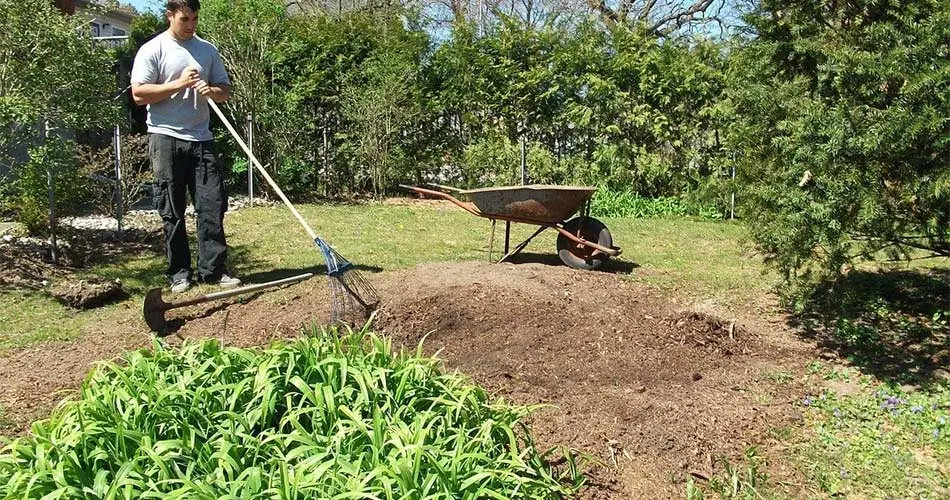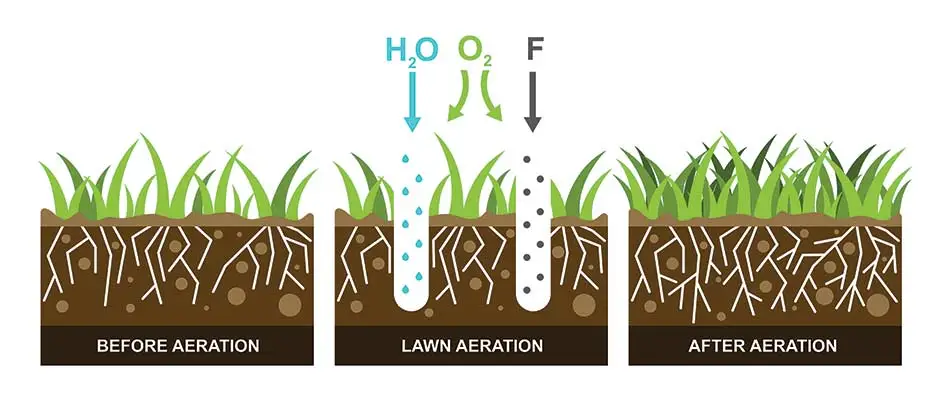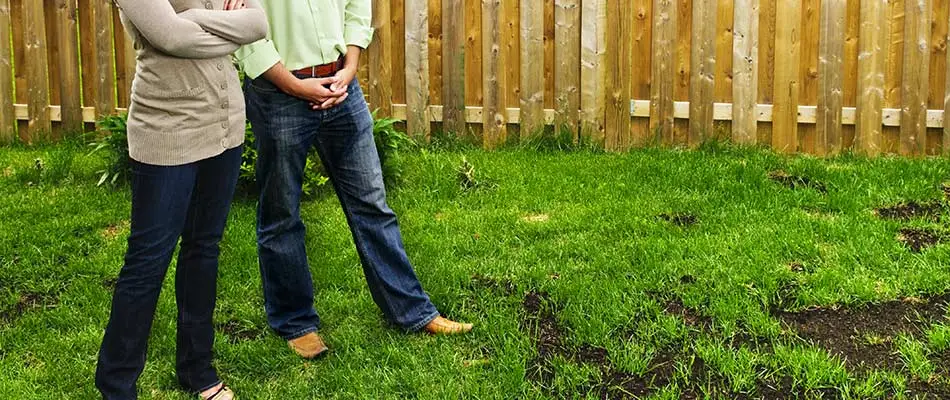You’ve just noticed some bare patches in the lawn, or maybe you’ve seen some tired-looking spots. May be there are scattered lumpy areas or places where weeds have invaded.
Although a lot of aspects of lawn care and landscaping can get pretty complicated (just have a look at our articles on fertilizing your lawn and pruning ornamental shrubs), this one seems like an easy, quick fix. Just lay some new turf grass down over the existing turf or plant some seeds among the grass that’s already there. Done!
Now, If Only It Were Really That Simple.
The question of whether you can put new turf down over old turf is a common one. Yes, you can do this, and it certainly does make returfing easier.
However, that’s really not the right question to ask. Instead, you should be asking whether laying new turfing over the old is a good idea.
As to the other option, planting new seeds over the existing grass (overseeding), the common assumption is that it should be done in the spring when a long growing season lies ahead.
Well, neither is a good idea. Both can be done, but both have serious drawbacks. We’re going to look at that now and then talk about what we think is the best option: fall overseeding.
Don't Lay New Turf Over Existing Turf
The reasons this isn’t such a good thing to do fall into two categories: soil compaction and preexisting problems.
When you lay new turf on top of existing turf, soil compaction results, and this inhibits growth. Before adding new turf, soil has to be dug up, churned about, and maybe replaced. Think of it as allowing the soil to “breathe” so that it can perform better.
If bad soil isn’t the culprit behind bare or weak patches, then drought, disease, weeds, or pests probably are. Simply putting new turf down will not address the underlying problem. Any lawn disease that exists will likely infect the new turf, killing or weakening it. Likewise, the root systems of weeds will still be there, and the weeds more likely than not will continue to grow.
Something many people do not know is that spots damaged by insects often look like spots damaged by drought. When the problem is soil-based insects such as grubs that eat grass roots, adding new turf and watering it properly will not address the problem. In fact, it is a gift to pests because they’ve just been given a free helping of nice new food!
Don't Overseed in the Spring
Spring seems like a great time to plant new grass since temperatures are warm, rain tends to be plentiful, and several warm (growth-friendly) months lie ahead.
This is true, and it can work with the right timing and with diligent care, but it’s tough to pull off because of two factors: summer and weeds.
Summer is the favorite time of year for a lot of people, and for good reasons, but it isn’t the favorite time of year for grass, especially new grass.
The dry conditions and hot temperatures of summer are very hard on grass, newly planted grass in particular. During the summer, growth slows drastically, almost to a complete halt much of the time, and grass that was newly planted in the spring usually lacks root systems that are strong enough and deep enough to withstand the conditions. As a result, the new grass frequently weakens or dies (or both) as it consumes more energy than it produces and lacks the nutrients it needs to stay healthy. Read more about spring seeding here.
That Results in Brown and Bare Patches

And That Results in Weeds
Although spring is a great time for grass to grow, it’s also a great time for weeds to grow. Herbicide treatments that block or attack weed growth work, but they also have the same effects on grass. Because of that, people sometimes apply herbicides first and then plant grass later in the spring, but that often works out terribly because the new grass has even less time to grow and strengthen ahead of summer, which is closer than ever before.
So whether you plant early or do weed control first and then plant, when those brown and bare patches appear, weeds such as crabgrass are more than happy to move in and take over.
All of a sudden, you have two problems to deal with: weak/dead grass and weeds. Fixing those problems is going to be a lot harder and a lot more expensive than doing it the right way in the first place would have been.
The Right Way: Fall Overseeding
Now we get to the point!
The best thing to do, unless the turf is extremely thin or mostly bare and maybe needs complete replacement, is to overseed in the fall.
Yes, that might not seem to make sense at first. After all, the remaining growing season is short, and winter is close, so it seems like a terrible time to plant new grass.
Only It Isn't.
Fall is a period of strong growth, and it’s long enough to provide a great start ahead of the dormant winter period. When spring returns, the fall growth starts anew with a strong base, and the grass is better prepared to survive the summer.
Why Overseed?
This is another common question from people who have established lawns. Once the lawn is thick and healthy, doesn’t it just take care of itself?
Ironically, a healthy, regularly mowed lawn is in one respect a detriment to itself because it never goes to seed and therefore never propagates itself. Instead, the older, established lawn requires additives and much manual labor. Even with that, the lawn will ultimately struggle to generate new growth and may cease creating it entirely.
Overseeding is a way to rejuvenate your lawn. It’s a way of keeping the good and adding the better.
How Do You Overseed?
Of course, the easiest way is to hire a pro, which will save you time and, perhaps counterintuitively, maybe money as well.
First, and as obvious as this sounds, choose the right seed for your climate! Here in the Sioux City area, cool-weather grasses such as fescues, ryegrass, and Kentucky bluegrass do best, and you want to make sure you plant those types of grasses. To anyone from other regions who has landed here, we love that you’re reading this, but please make sure to seek region-specific advice before making important lawn-care decisions.
Back to the subject...
Aerate
Next, aerate the lawn. If you’d like to know in-depth details about this procedure, please read our Learning Center article on aeration.

The short version is this:
- Aeration creates small “holes” in your lawn.
- Aeration helps manage the thatch, which is the layer of decaying organic material between the soil and the crown (the top of your grass). When the thatch becomes too thick, then water, sunlight, and essential nutrients struggle or fail to penetrate the soil and reach the grass roots. We’ve already talked about what happens when the grass is lacking what it needs.
- The holes that aeration creates allow that needed light, water, and nutrients to penetrate.
- As much as possible, make sure that new seeds get into those holes.
- As a result, grass growth is thicker and stronger, which in turn is the best defense against weeds and insect pests.
Aeration and dethatching are time- and work-intensive. Calling a pro in will definitely save you time and effort and might save you money as well if you don’t already have the equipment and the know-how.
Let’s not talk about how much more expensive it gets when someone goes the DIY way and gets it wrong!
After Overseeding
We’d love to tell you that after following all of the above, you can just sit back and enjoy your beautiful lawn, but that just isn’t true, and even if you do it all on your own, we have an ethical obligation to inform you that there’s more to it.
Fertilize and Water
Apply a good fall fertilizer and then water up to twice per day until new growth shows. Be patient; this can take two weeks or more. Keep mowing as proper for your lawn until the growing season ends and winter gives you a break. Through the fall, keep the new growth moist.
To cover or Not to Cover?
Hamlet’s question was deeper in an existential sense, but it’s more relevant to most homeowners to ask if they should or shouldn’t cover seeds with soil or existing grass. This depends on climate, the health of the present grass, and other conditions.
Most pros will cover new seeds with a thin layer of soil, but every yard is different. If in doubt, consult a pro.
A Cure for the Headaches
Your time is valuable. So is your hard-earned money.
The common argument against hiring a lawn-care pro is that lawn care is simple and you can save money doing it yourself. At this point, though, you can probably see that it’s not so simple and that for a lot of people, the DIY way will be more expensive in the long run.
Sharp Lawn Care has been an industry leader for nearly two decades now. Our expertise, professionalism, and reliability are without peer.
You can talk to us obligation-free to learn more about our services. Just use our easy online form to ask questions or request a free quote. We look forward to meeting you and helping to beautify and protect your home!




Comments (0)
Thanks for your comment!
Thanks for your feedback! Your comments have been successfully submitted! Please note, all comments require admin approval prior to display.
Error submitting comment!
There is a problem with your comment, please see below and try again.